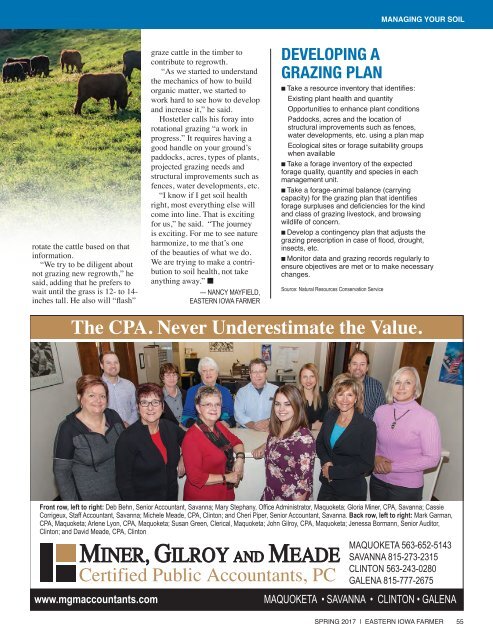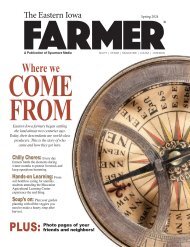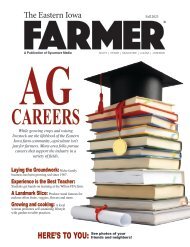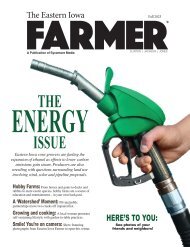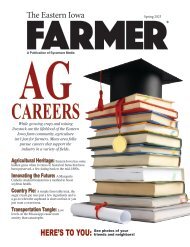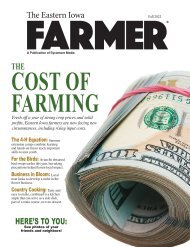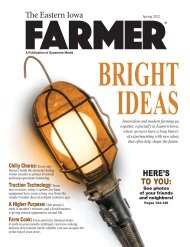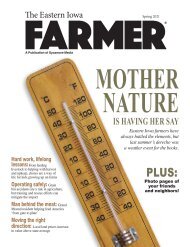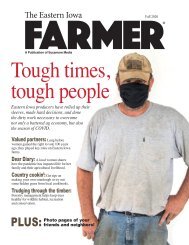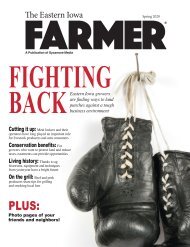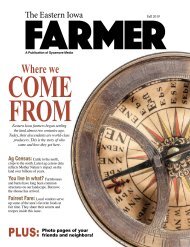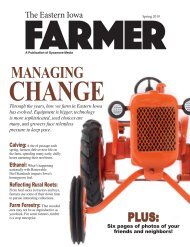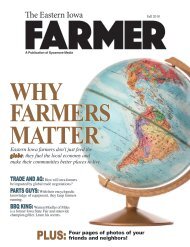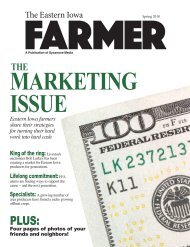Create successful ePaper yourself
Turn your PDF publications into a flip-book with our unique Google optimized e-Paper software.
managing your soil<br />
rotate the cattle based on that<br />
information.<br />
“We try to be diligent about<br />
not grazing new regrowth,” he<br />
said, adding that he prefers to<br />
wait until the grass is 12- to 14-<br />
inches tall. He also will “flash”<br />
graze cattle in the timber to<br />
contribute to regrowth.<br />
“As we started to understand<br />
the mechanics of how to build<br />
organic matter, we started to<br />
work hard to see how to develop<br />
and increase it,” he said.<br />
Hostetler calls his foray into<br />
rotational grazing “a work in<br />
progress.” It requires having a<br />
good handle on your ground’s<br />
paddocks, acres, types of plants,<br />
projected grazing needs and<br />
structural improvements such as<br />
fences, water developments, etc.<br />
“I know if I get soil health<br />
right, most everything else will<br />
come into line. That is exciting<br />
for us,” he said. “The journey<br />
is exciting. For me to see nature<br />
harmonize, to me that’s one<br />
of the beauties of what we do.<br />
We are trying to make a contribution<br />
to soil health, not take<br />
anything away.” n<br />
— Nancy mayfield,<br />
eastern iowa farmer<br />
Developing a<br />
Grazing Plan<br />
n Take a resource inventory that identifies:<br />
Existing plant health and quantity<br />
Opportunities to enhance plant conditions<br />
Paddocks, acres and the location of<br />
structural improvements such as fences,<br />
water developments, etc. using a plan map<br />
Ecological sites or forage suitability groups<br />
when available<br />
n Take a forage inventory of the expected<br />
forage quality, quantity and species in each<br />
management unit.<br />
n Take a forage-animal balance (carrying<br />
capacity) for the grazing plan that identifies<br />
forage surpluses and deficiencies for the kind<br />
and class of grazing livestock, and browsing<br />
wildlife of concern.<br />
n Develop a contingency plan that adjusts the<br />
grazing prescription in case of flood, drought,<br />
insects, etc.<br />
n Monitor data and grazing records regularly to<br />
ensure objectives are met or to make necessary<br />
changes.<br />
Source: Natural Resources Conservation Service<br />
The CPA. Never Underestimate the Value.<br />
Front row, left to right: Deb Behn, Senior accountant, Savanna; Mary Stephany, office administrator, Maquoketa; Gloria Miner, CPa, Savanna; Cassie<br />
Corrigeux, Staff accountant, Savanna; Michele Meade, CPa, Clinton; and Cheri Piper, Senior accountant, Savanna. Back row, left to right: Mark Garman,<br />
CPa, Maquoketa; arlene lyon, CPa, Maquoketa; Susan Green, Clerical, Maquoketa; John Gilroy, CPa, Maquoketa; Jenessa Bormann, Senior auditor,<br />
Clinton; and David Meade, CPa, Clinton<br />
Maquoketa 563-652-5143<br />
Savanna 815-273-2315<br />
Clinton 563-243-0280<br />
Galena 815-777-2675<br />
www.mgmaccountants.com<br />
Maquoketa • Savanna • Clinton • Galena<br />
spring <strong>2017</strong> | <strong>Eastern</strong> <strong>Iowa</strong> <strong>Farmer</strong> 55


